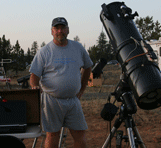Posts for: Astrofun
Jun 11, 2012 09:01:05 #
For $35 (recurring monthly subscription) you can join and try them out. That's what I did as a skeptic, then bought the starter / fundamentals discs for the two Adobe Elements 10 programs that I use (Photoshop Elements 10 Essentials (pictures) and Premier Elements 10 Essentials (video). I'm not pushing either, its just that I put off buying Elements and got it last Christmas, and then looked high and low for a good training / tutorial editing set. Adobe has their own that was really hard to follow. Thus one from Lynda.com was logical and (for the most part) easy to follow. There are deeper video sessions for the curious who want more than the basics, but you pretty much have to stay subscribed to access those. I figure I'll go back on a basic annual subscription when I master the fundamentals!
Jun 10, 2012 18:10:10 #
Subscribed to Lynda.com to see if I could get a little more out of Photoshop Elements 10 than red eye fix and skin tone corrections, and played around with their 'Photoshop Elements 10 Essentials' chapters on selections and layer masks. Not sure if that site is worth the subscription rate unless you're really serious, but you can buy the Photoshop Elements 10 Essentials and Premier Elements 10 Essentials DVDs for $50 each, and those two really get you over the learning curve hump quick. I had a bunch of shots I took of an eagle that was feasting on some roadkill on a N Calif trip and I wanted to see if I could make something eye-pleasing out of the 50-or-so shots I took. Not sure this will make it to Look Magazine (dating myself, here), but its fun to play with. I find the first uses of a software to be the hardest, and these DVDs are clear, understandable and well organized. Anyone else have any experience with these DVDs tot get functional in Elements 10?
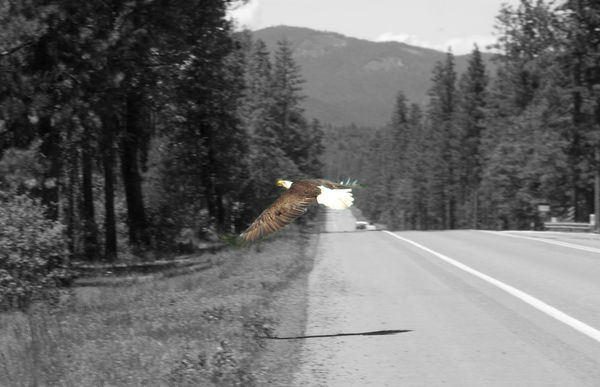
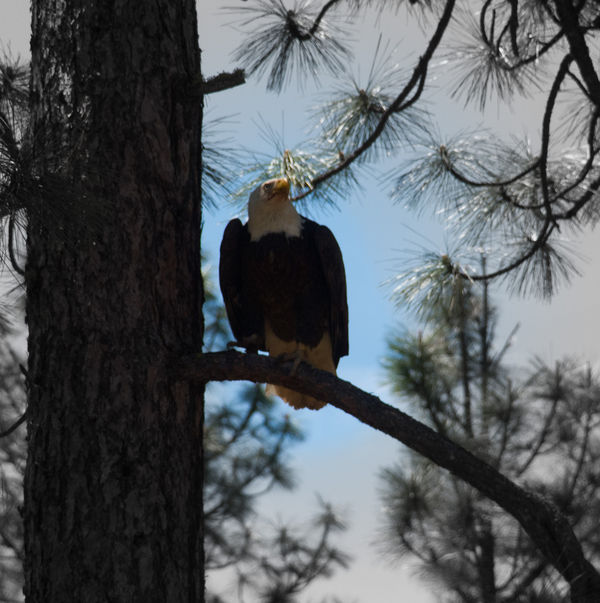
Jun 7, 2012 10:27:20 #
Yes, living just outside Seattle I am well aware of how clouds can impact astrophotography. This was especially upsetting because I spent a few hundred dollars getting my scope set up for solar. The solar filter (scope and view-finder) arrived a week before the annular eclipse on May 21st, but of course there were all cloudy days so I didn't have a chance to practice with it (if I had I would have realized how important centering the sun in the scope is, that you should keep your ISO as low as possible, and that you need a thick, opaque towel to put over your head and the camera video screen to get sharp focus).
Chased the annular eclipse down to Shasta CA to combine it with a visit to brother-in-law, and then that morning had to further escape Shasta's clouds and drive toward E California past Mt Lassen before the skies cleared and I ran out of time before the eclipse started. Got the whole thing, including the attached shot of Bailey's Beads (when moon is at edge of sun and sunlight shines through valleys but is occluded by mountains). 1,500 mi of driving for 4.5 min of totality!
Tuesday I was better prepared with the equipment, but no better prepared with the weather, and ended up driving to E Washington, and then I only got about an hour of clear skies out of the whole transit (so I only have pics of venus half-way through its transit). One pic is with a little high clouds giving it a bit of an artsy look, but the last (my best shot) is a good clear one.
Chased the annular eclipse down to Shasta CA to combine it with a visit to brother-in-law, and then that morning had to further escape Shasta's clouds and drive toward E California past Mt Lassen before the skies cleared and I ran out of time before the eclipse started. Got the whole thing, including the attached shot of Bailey's Beads (when moon is at edge of sun and sunlight shines through valleys but is occluded by mountains). 1,500 mi of driving for 4.5 min of totality!
Tuesday I was better prepared with the equipment, but no better prepared with the weather, and ended up driving to E Washington, and then I only got about an hour of clear skies out of the whole transit (so I only have pics of venus half-way through its transit). One pic is with a little high clouds giving it a bit of an artsy look, but the last (my best shot) is a good clear one.
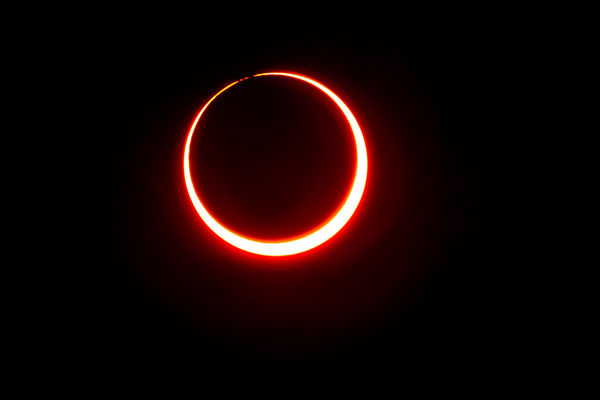
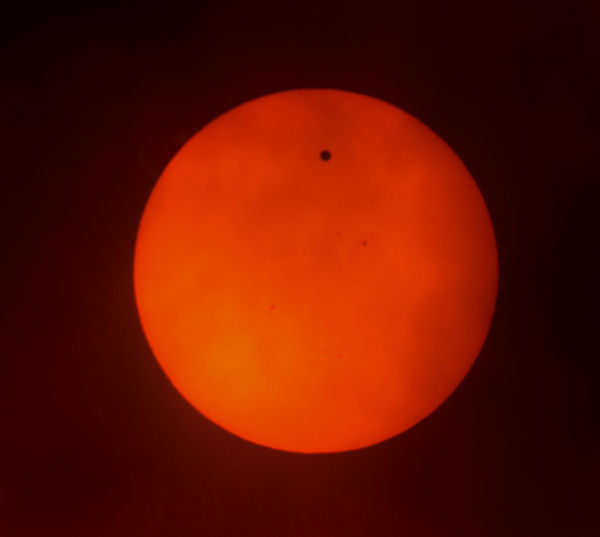
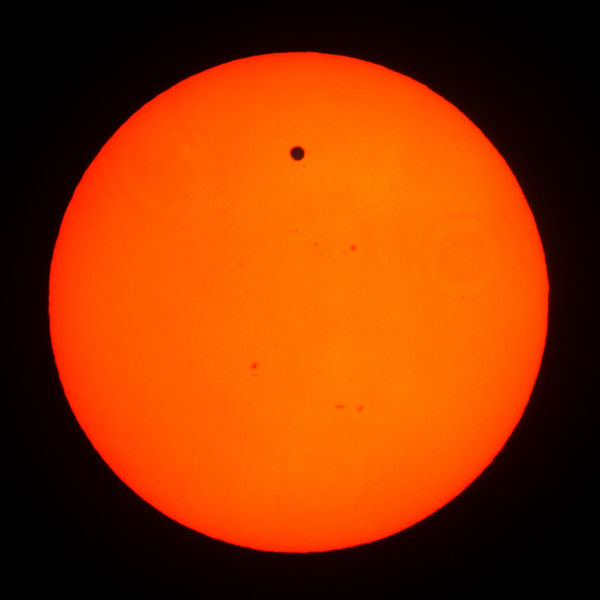
Jun 7, 2012 10:25:45 #
Yes, living just outside Seattle I am well aware of how clouds can impact astrophotography. This was especially upsetting because I spent a few hundred dollars getting my scope set up for solar. The solar filter (scope and view-finder) arrived a week before the annular eclipse on May 21st, but of course there were all cloudy days so I didn't have a chance to practice with it (if I had I would have realized how important centering the sun in the scope is, that you should keep your ISO as low as possible, and that you need a thick, opaque towel to put over your head and the camera video screen to get sharp focus).
Chased the annular eclipse down to Shasta CA to combine it with a visit to brother-in-law, and then that morning had to further escape Shasta's clouds and drive toward E California past Mt Lassen before the skies cleared and I ran out of time before the eclipse started. Got the whole thing, including the attached shot of Bailey's Beads (when moon is at edge of sun and sunlight shines through valleys but is occluded by mountains). 1,500 mi of driving for 4.5 min of totality!
Tuesday I was better prepared with the equipment, but no better prepared with the weather, and ended up driving to E Washington, and then I only got about an hour of clear skies out of the whole transit (so I only have pics of venus half-way through its transit). One pic is with a little high clouds giving it a bit of an artsy look, but the last (my best shot) is a good clear one with sun's corona visible.
Chased the annular eclipse down to Shasta CA to combine it with a visit to brother-in-law, and then that morning had to further escape Shasta's clouds and drive toward E California past Mt Lassen before the skies cleared and I ran out of time before the eclipse started. Got the whole thing, including the attached shot of Bailey's Beads (when moon is at edge of sun and sunlight shines through valleys but is occluded by mountains). 1,500 mi of driving for 4.5 min of totality!
Tuesday I was better prepared with the equipment, but no better prepared with the weather, and ended up driving to E Washington, and then I only got about an hour of clear skies out of the whole transit (so I only have pics of venus half-way through its transit). One pic is with a little high clouds giving it a bit of an artsy look, but the last (my best shot) is a good clear one with sun's corona visible.
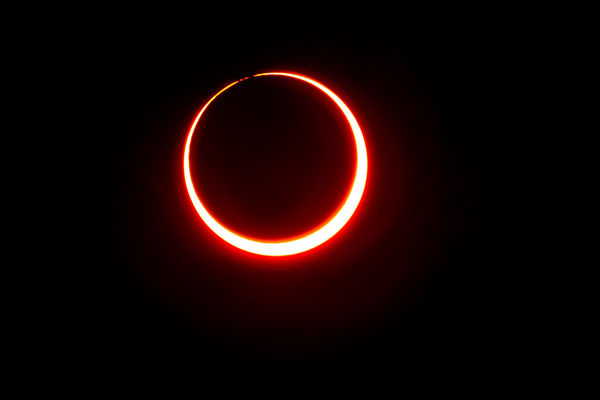
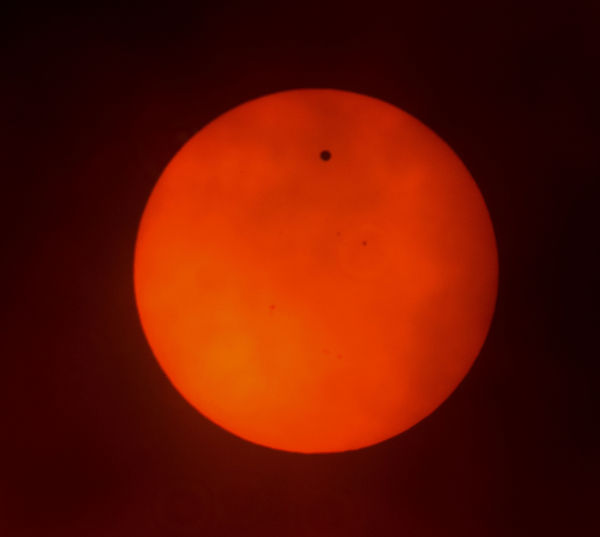
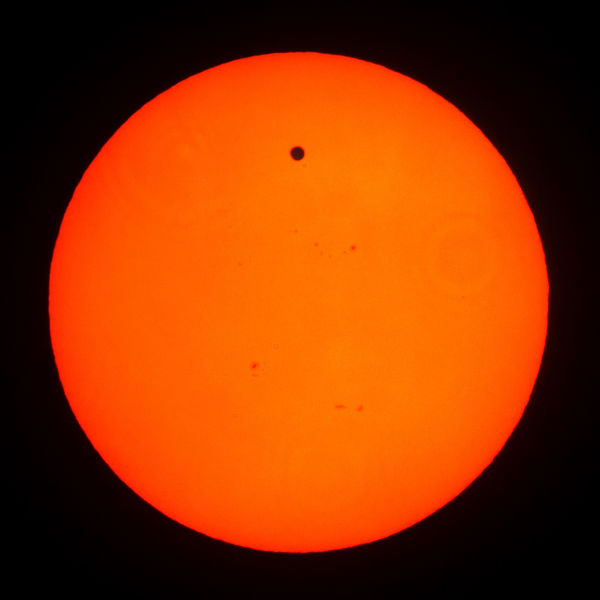
Jun 6, 2012 22:36:55 #
Here is one of my better shots of yesterday's Venus transit of the sun. Another astrophotography adventure in the rainy + cloudy Pacific Northwest, but I got enough sun-breaks on the east side of the mountains to at least be able to photo-document that I saw it. Good thing because it doesn't happen again for 105 years!
Shot at ISO 400 at 1,4000 sec through a Hap Griffin modified Canon T2i (internal IR filter replaced with a neutral filter) in direct-focus set-up through an f/4.7 6" Mak-Newt telescope with a solar filter.
Shot at ISO 400 at 1,4000 sec through a Hap Griffin modified Canon T2i (internal IR filter replaced with a neutral filter) in direct-focus set-up through an f/4.7 6" Mak-Newt telescope with a solar filter.
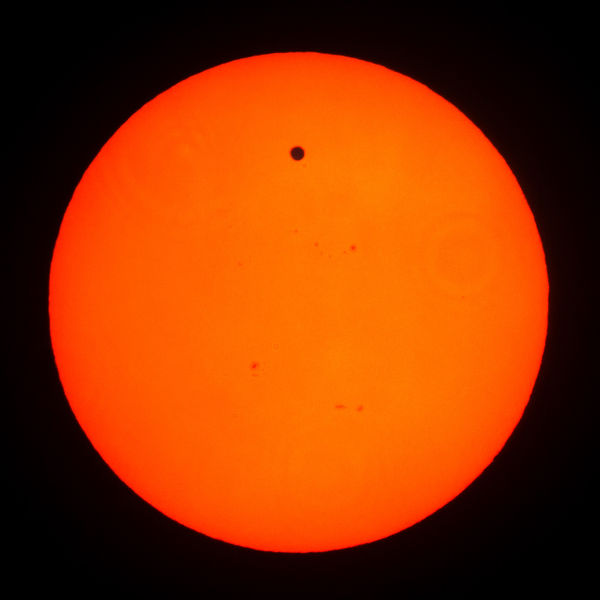
May 31, 2012 00:23:12 #
Be careful about 'low-cost' options like smoked glass. You burn your retinas irreversibly before you even start to feel the pain by using too weak a filter. The cheapest safe way is to go to a welding supply store and buy a full-face welders mask replacement glass that is a #14. I bought mine for $15. You'll then need at least a 200mm telephoto to fill the viewfinder as Venus will be a small oval covering about 5% of the total sun's surface (no where near as noticeable as the annular eclipse was). See the attached clip from a web page of the 2011 transit for an example of what you need to look for (note... this pic is from http://www.csmonitor.com/Science/2012/0530/Transit-of-Venus-Early-tape-measure-for-size-of-our-solar-system-video)
Put you camera in a tripod so you have a free hand, and set the ISO at 100 and the camera at Shutter-speed priority. The camera's metering should give you the right exposure, but it wouldn't be a bad idea to bracket you exposures +/- 1/2 f-stop.
Hold the welders glass flat against the lens and then look through the viewfinder to aim at the sun (carefully shielding your other eye). If you don't hold the welders glass flat you'll get odd colors as the sunlight passes transversely through the filter material. Not sure why this is since its not a polarizing filter, but that was what I experienced during the solar eclipse last week.
You'll have plenty of time to get the setting right and the Venus transit will last about 6 hours, but Venus doesn't make first contact with the sun's edge until 6:04pm EDT (3:04pm PDT). So the transit will end after sunset for most of the US except to the NW part of the country.
Put you camera in a tripod so you have a free hand, and set the ISO at 100 and the camera at Shutter-speed priority. The camera's metering should give you the right exposure, but it wouldn't be a bad idea to bracket you exposures +/- 1/2 f-stop.
Hold the welders glass flat against the lens and then look through the viewfinder to aim at the sun (carefully shielding your other eye). If you don't hold the welders glass flat you'll get odd colors as the sunlight passes transversely through the filter material. Not sure why this is since its not a polarizing filter, but that was what I experienced during the solar eclipse last week.
You'll have plenty of time to get the setting right and the Venus transit will last about 6 hours, but Venus doesn't make first contact with the sun's edge until 6:04pm EDT (3:04pm PDT). So the transit will end after sunset for most of the US except to the NW part of the country.
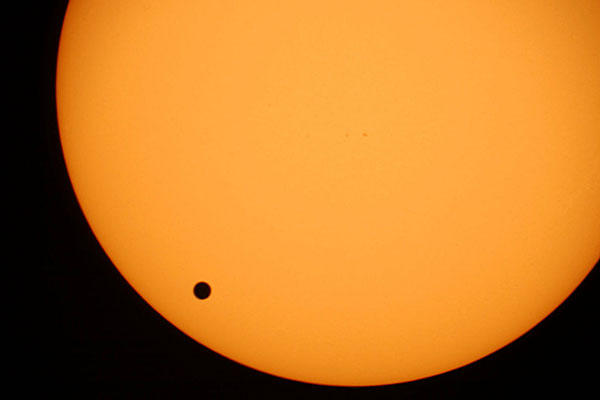
May 30, 2012 23:44:40 #
Bruce,
A good, free software program for stacking astronomy pictures is RegiStax (http://www.astronomie.be/registax/), which is most suited for either rapid-sequence DSLR pics or video. It automatically sorts, then grades the clearest shots, and then stacks them. If you had done any of these same shots from a tripod and rapid-burst a dozen or so shots, RegiStax would have picked up the best of those and you would have ended up with a stacked picture with a lot more clarity and contrast (not that these weren't nice to start). This is just another FREE software tool to play with.
A good, free software program for stacking astronomy pictures is RegiStax (http://www.astronomie.be/registax/), which is most suited for either rapid-sequence DSLR pics or video. It automatically sorts, then grades the clearest shots, and then stacks them. If you had done any of these same shots from a tripod and rapid-burst a dozen or so shots, RegiStax would have picked up the best of those and you would have ended up with a stacked picture with a lot more clarity and contrast (not that these weren't nice to start). This is just another FREE software tool to play with.
May 30, 2012 23:19:34 #
Here's a very amateurish attempt to crop my Bailey's Beads pic into a landscape view of Mt Lassen in CA. I'm just developing my Photoshop Elements skills.
In true amateur astronomy fashion we drove from Woodinville WA (near Seattle) to Shasta CA to get into the path of totality. Then after driving that far the forecast for Shasta wasn't very good so we drove that morning toward eastern CA, ending up betting as far as Mt Lassen before we ran out f driving time and I had to stop and get the telescope set up. Got things set up just as the eclipse started, so I captured the while thing.
While the total span of the eclipse was about 4h30m, the duration of the total eclipse was a little more than 4 minutes. So we essentially drove 1,500mi for 4 minutes of total eclipse.
What do you mean, crazy... :roll: ?
In true amateur astronomy fashion we drove from Woodinville WA (near Seattle) to Shasta CA to get into the path of totality. Then after driving that far the forecast for Shasta wasn't very good so we drove that morning toward eastern CA, ending up betting as far as Mt Lassen before we ran out f driving time and I had to stop and get the telescope set up. Got things set up just as the eclipse started, so I captured the while thing.
While the total span of the eclipse was about 4h30m, the duration of the total eclipse was a little more than 4 minutes. So we essentially drove 1,500mi for 4 minutes of total eclipse.
What do you mean, crazy... :roll: ?
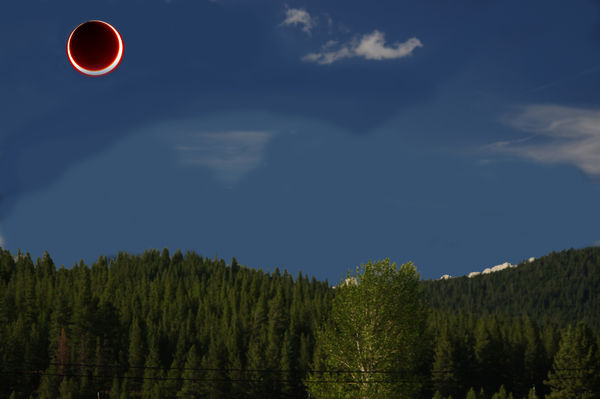
May 28, 2012 23:24:09 #
Bailey's Beads occur at 2nd and 3rd touch in a solar eclipse when the rugged lunar topography allows beads of sunlight to shine through in between mountains. This effect is called Baily's Beads in honor of Francis Baily who first provided an exact explanation of the phenomenon, Shot near Mt Lassen CA with Hap Griffin-adjusted Canon T2i Rebel (IR filter removed) through a 6" Mak-Newtonian telescope (f/4.9) with solar filter.
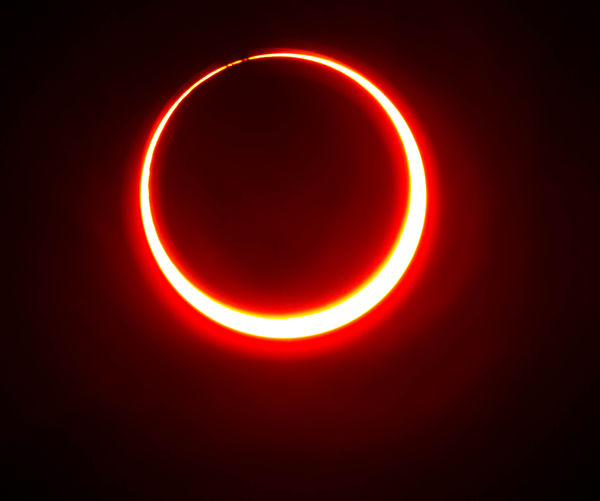
May 20, 2012 12:26:14 #
And you are also just outside the edge where the weather service predicts afternoon clouds. The very E part of Calif and then Nevada thru New Mexico are the only areas in the US within the band of total annularity that are predicted to have clear skies (swath where, clouds permitting, you'll be able to see all of the moon within the circumference of the sun).
As many astronomy fans people will do for events like this, I drove 1600 miles roundtrip from Woodinville WA to Shasta CA to visit in-laws and to get 4 1/2 minutes of annularity. Now I have to drive another 3 hours each way to Susanville (or farther) to get away from a front moving into the Ca/Or coast area. A total of ~24 hrs of driving for 350 seconds of astronomy... good thing I'm not crazy, huh...
As many astronomy fans people will do for events like this, I drove 1600 miles roundtrip from Woodinville WA to Shasta CA to visit in-laws and to get 4 1/2 minutes of annularity. Now I have to drive another 3 hours each way to Susanville (or farther) to get away from a front moving into the Ca/Or coast area. A total of ~24 hrs of driving for 350 seconds of astronomy... good thing I'm not crazy, huh...
May 20, 2012 12:15:15 #
You can always tell how new someone is a drive-thru window by how long they stare blankly when you give them exact change. What is it... available knowledge doubles every 11 years (and I expect that learned content from our schools halves).
May 20, 2012 11:52:41 #
Hi. Not sure how many people in this forum are into astrophotography, but that is my area in which I hope to become rich and famous... or at least have fun. I have been doing hack photo artwork for years, but the fact that I only have one "artsy" tag in my Elements catalog to capture all my photo art is a statement to how diverse I think my skill and subject base is. I've been building my astrophotography skill set for about 3 years and I watch the mailbox daily for my first invite to have a show around my collection of work. Until then I'll hack my way around and learn tricks and, if nothing else, it beats my day job hands down.
I look forward to discussions with others interested in astrophotography, and tricks and trips for Photoshop Elements (I keep the latest version). I'm a Canon guy, with a T2i and I have a10' Orion newtonian scope and a 6' Explore Scientific Mak-Newt scope with an Atlas EQ-G go-to mount driven by laptop using EQMOD, and Stark Labs Nebulosity. I'm on the smallish and less complex side of spectrum of scope set-ups you'll see at star parties, but that doesn't mean I have any better luck in the field with electronics that worked perfectly the day before at home (Murphy is a perverse son-of-a-gun).
As is the common sign-off in astronomy forums, 'Clear skies'
I look forward to discussions with others interested in astrophotography, and tricks and trips for Photoshop Elements (I keep the latest version). I'm a Canon guy, with a T2i and I have a10' Orion newtonian scope and a 6' Explore Scientific Mak-Newt scope with an Atlas EQ-G go-to mount driven by laptop using EQMOD, and Stark Labs Nebulosity. I'm on the smallish and less complex side of spectrum of scope set-ups you'll see at star parties, but that doesn't mean I have any better luck in the field with electronics that worked perfectly the day before at home (Murphy is a perverse son-of-a-gun).
As is the common sign-off in astronomy forums, 'Clear skies'
